Mexican cuisine is a vibrant and rich culinary tradition that has captivated food lovers around the world. From the zesty flavors of fresh salsas to the comforting warmth of tortillas, this cuisine showcases a variety of ingredients and techniques that celebrate the cultural heritage of Mexico. In this article, we will explore authentic Mexican recipes, delve into the history of traditional dishes, and provide practical tips for preparing these meals at home.
Key Takeaways
- Core Ingredients: Mexican cuisine relies on staple ingredients such as corn, beans, chili peppers, and a variety of spices, which contribute to its bold flavors and rich textures.
- Signature Dishes: Popular Mexican dishes like tacos, tamales, enchiladas, and salsas showcase the depth and versatility of traditional ingredients.
- Cooking Techniques: Essential techniques like roasting chiles and preparing fresh salsas add unique flavors to Mexican recipes and can easily be practiced at home.
- Regional Variations: Mexico’s diverse geography influences its cuisine, with regional specialties like beef dishes in the north, moles in the center, and tropical fruit and seafood in the south.
- Cultural Significance: Mexican cuisine is deeply tied to cultural traditions and family gatherings, where food plays a central role in celebrations and daily life.
- Authentic Tips: Use fresh, high-quality ingredients, experiment with spices, and embrace traditional presentation to bring out the authentic flavors of Mexican cuisine in your cooking.
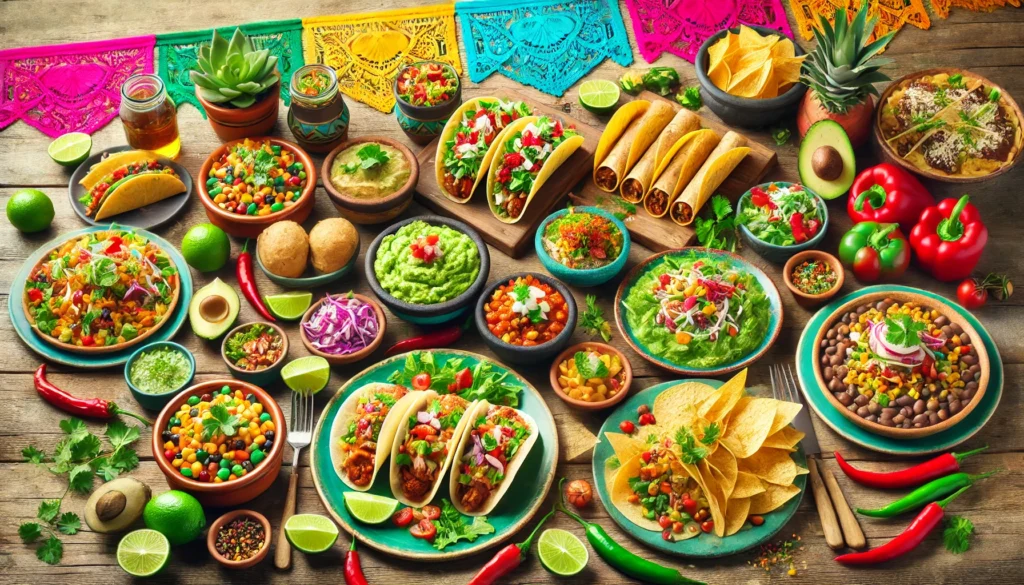
The Essence of Mexican Cuisine
Mexican cuisine is characterized by its use of fresh, local ingredients and bold flavors. Essential components include corn, beans, chili peppers, and a wide array of spices. The unique blend of indigenous and Spanish influences has shaped the development of various regional dishes across the country.
Mexico’s biodiversity is key to its rich culinary tradition. From the arid climates of the north to the tropical zones in the south, the variety of crops provides a unique selection of fresh, native ingredients. This access to fresh produce has allowed for the creation of authentic dishes that preserve a culinary heritage blending complex flavors with Mexico’s indigenous and colonial history, making each dish a true celebration of the land.
Ingredients that Define Mexican Cuisine
Each of these ingredients defines not only the flavor but also the purpose of Mexican recipes. For example, corn is the backbone of the Mexican diet, transforming into tortillas, tamales, or even traditional drinks like atole. The versatility of chilies allows for sauces that range from mild to intensely spicy, adapting to different tastes and dishes. For those looking to recreate these recipes outside Mexico, many ingredients have substitutes, such as using corn flour to make fresh tortillas when masa harina is not available.
- Corn: The backbone of Mexican cooking, corn is used to make tortillas, tamales, and masa for various dishes.
- Beans: A staple source of protein, beans come in many varieties, such as black, pinto, and kidney.
- Chili Peppers: From mild to spicy, chili peppers add depth and heat to sauces and dishes.
- Herbs and Spices: Fresh cilantro, oregano, cumin, and garlic are commonly used to enhance flavors.
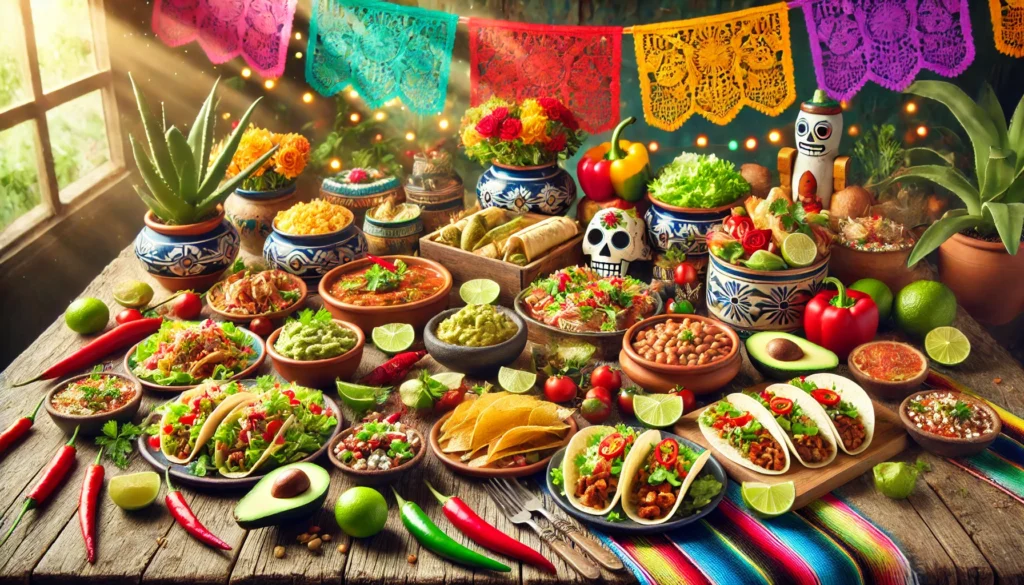
Popular Dishes in Mexican Cuisine
Some of the best-known dishes that exemplify Mexican cuisine include:
- Tacos: Soft or hard-shell tortillas filled with a variety of ingredients, such as meat, beans, cheese, and vegetables.
- Enchiladas: Corn tortillas rolled around a filling, topped with chili sauce and cheese.
- Tamales: Steamed masa filled with meats, cheeses, or vegetables, wrapped in corn husks.
- Salsas: Fresh or cooked sauces made with tomatoes, chili peppers, onions, and spices.
Authentic Recipes to Try at Home
Now that we have a better understanding of the ingredients and dishes that define Mexican cuisine, let’s dive into some authentic recipes that you can try at home.
Exploring authentic Mexican recipes allows home cooks to engage with Mexico’s vibrant culinary tradition, bringing beloved dishes into their kitchens. The process of preparing Mexican food—whether it’s grinding fresh salsa in a molcajete or steaming tamales in corn husks—captures the essence of Mexican cuisine and allows you to appreciate the artistry behind each dish. These recipes offer a taste of Mexico’s heritage and are perfect for gatherings, adding a touch of authenticity and flavor to any meal.
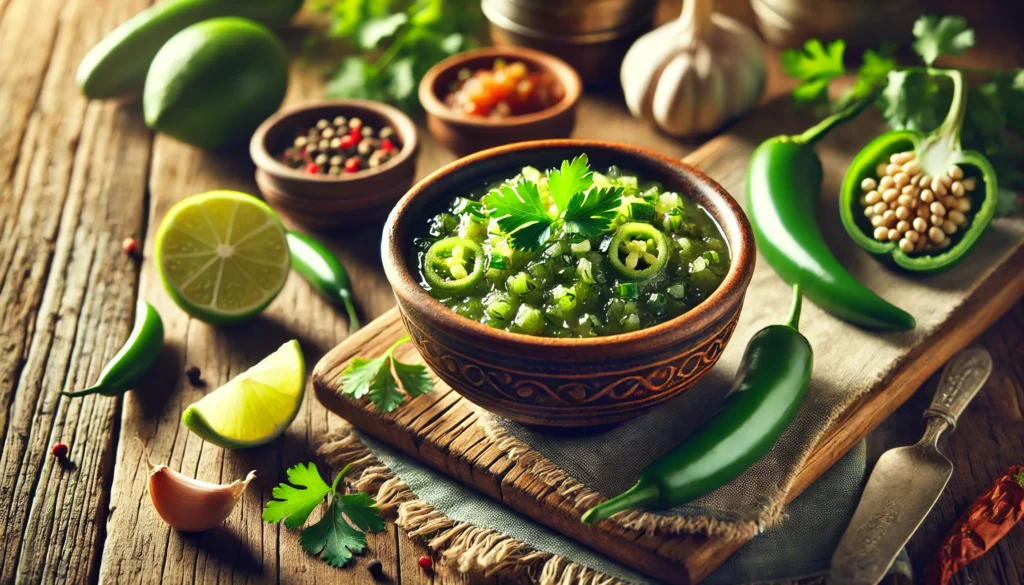
1. Classic Salsa Verde
Ingredients:
- 1 lb. tomatillos, husked and rinsed
- 1-2 jalapeño peppers (to taste)
- 1/2 cup chopped onion
- 1/4 cup fresh cilantro
- Salt to taste
Instructions:
- In a saucepan, boil the tomatillos and jalapeños for about 10 minutes until soft.
- Drain and place in a blender with onion, cilantro, and salt. Blend until smooth.
- Adjust seasoning as needed and serve with tortilla chips or as a topping for tacos.
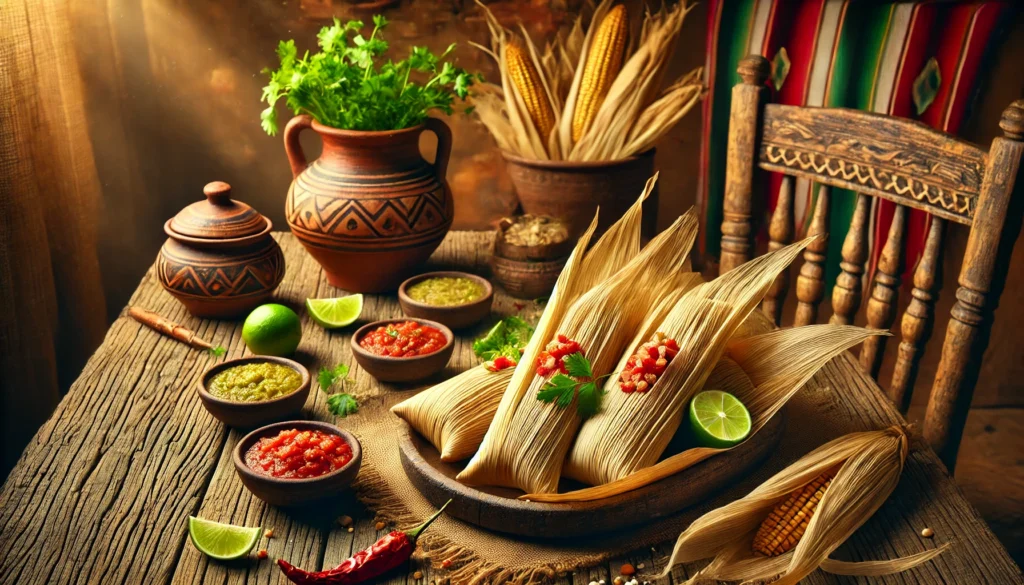
2. Traditional Tamales
Ingredients:
- 2 cups masa harina
- 1/2 cup vegetable shortening
- 1 1/2 cups vegetable broth
- 1 tsp baking powder
- Filling of your choice (pork, chicken, cheese, or beans)
- Corn husks, soaked in water
Instructions:
- In a large bowl, beat the shortening until fluffy. Gradually add masa hari, baking powder, and vegetable broth. Mix until a dough forms.
- Spread about 2 tablespoons of dough on a soaked corn husk. Place a tablespoon of filling in the center and fold the husk around it.
- Steam the tamales for about 1 hour or until the masa pulls away from the husk.
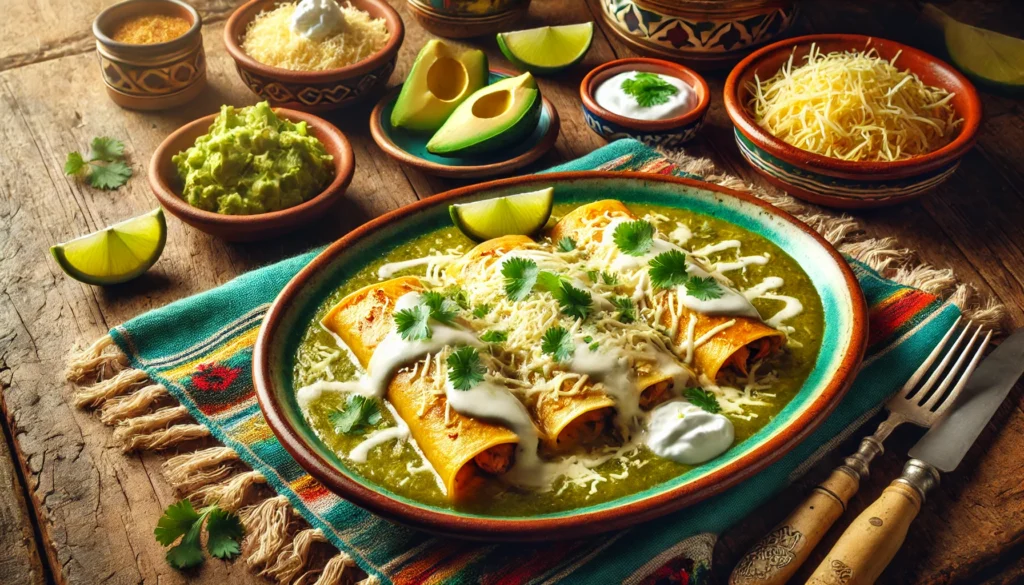
3. Enchiladas Suizas
Ingredients:
- 12 corn tortillas
- 2 cups cooked chicken, shredded
- 1 cup green salsa
- 1 cup sour cream
- 1 cup shredded cheese (such as Monterey Jack)
Instructions:
- Preheat the oven to 375°F (190°C).
- In a skillet, warm the tortillas slightly to make them pliable. Fill each with shredded chicken, roll, and place in a baking dish.
- Mix green salsa and sour cream, then pour over the enchiladas. Top with shredded cheese.
- Bake for 20 minutes or until the cheese is bubbly and golden.
The Cultural Significance of Mexican Cuisine
Mexican food is more than just a meal; it’s a significant part of cultural identity and tradition. Celebrations, holidays, and family gatherings often revolve around food, showcasing the importance of shared meals.
Mexican food plays a central role in cultural celebrations such as Día de los Muertos and national holidays. During Día de los Muertos, tamales, pan de muerto, and other dishes are prepared to honor loved ones, creating a link across generations through food. During celebrations like Mexico’s Independence Day, dishes like pozole and chiles en nogada stand out, showing how food becomes an expression of national pride and family unity. Each dish is not only a meal but a symbol of tradition and community.
Regional Variations
One of the most distinctive regions is Oaxaca, known as the ‘land of the seven moles.’ Oaxacan moles are famous for their complexity, combining chiles, spices, chocolate, and seeds into rich, aromatic sauces that take hours to prepare. In Yucatán, Mayan influence is evident in dishes like cochinita pibil, which is cooked in an earthen oven and marinated with achiote, giving it a vibrant color and unique flavor.
Mexico’s diverse geography and climate contribute to the regional variations in its cuisine. For example:
- Northern Mexico: Known for its beef dishes and cheese.
- Central Mexico: Famous for its moles and complex sauces.
- Southern Mexico: Renowned for its use of tropical fruits and seafood.
Tips for Cooking Authentic Mexican Cuisine
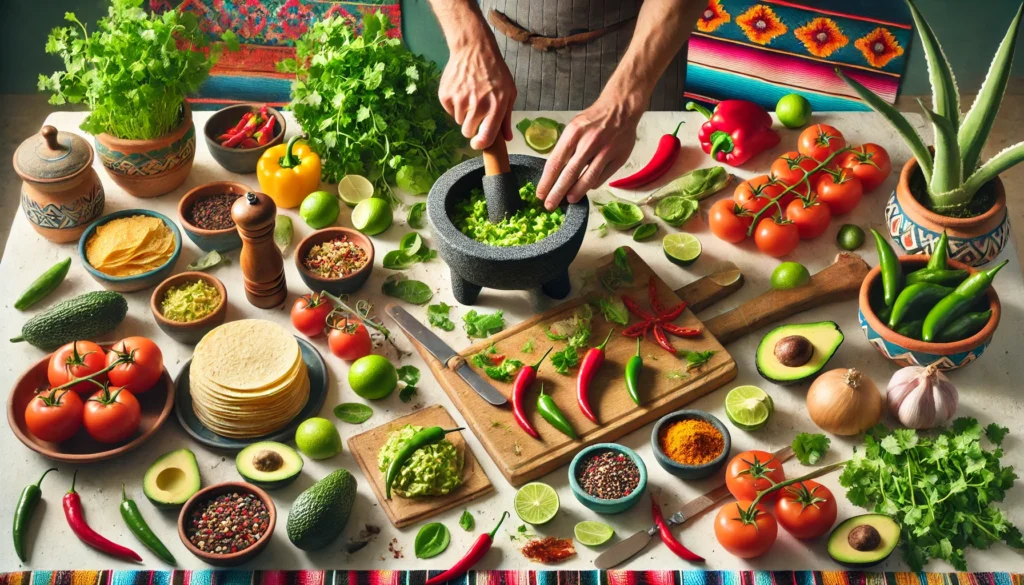
To create authentic Mexican dishes at home, consider the following tips:
- Use fresh ingredients: Opt for fresh, high-quality ingredients to enhance flavor.
- Experiment with Spices: Don’t be afraid to adjust spices to suit your taste. Mexican cuisine often balances flavors between spicy, sweet, and savory.
- Practice Cooking Techniques: Learn essential techniques such as making tortillas from scratch or roasting chiles for salsas.
- Serve with Tradition: Presentation matters in Mexican cuisine. Serve dishes with fresh herbs, lime wedges, and colorful garnishes.
Conclusion
Mexican cuisine is a celebration of vibrant flavors, rich cultural history, and culinary artistry. From the earthy notes of corn and beans to the fiery kick of chili peppers, each ingredient and dish embodies a piece of Mexico’s heritage.
Preparing authentic Mexican food at home allows us to experience these traditions firsthand, creating meals that are as meaningful as they are delicious. Whether you’re making a simple salsa or crafting complex enchiladas, each recipe is an opportunity to connect with a cuisine that is deeply woven into family gatherings and festive occasions.
Embrace fresh ingredients, experiment with spices, and savor the process—because Mexican cuisine is more than just food; it’s a bridge to a dynamic and cherished culture.
FAQ
What are the main ingredients in Mexican cuisine?
Common ingredients include corn, beans, chili peppers, tomatoes, and a variety of spices.
What is the difference between salsa roja and salsa verde?
Salsa roja is made with red tomatoes, while salsa verde is made with tomatoes and green chilies.
Can I make authentic Mexican food without specialized ingredients?
While some recipes may require specific ingredients, many traditional dishes can be adapted using readily available items.
How can I make my Mexican food less spicy?
To reduce the heat, use milder chili varieties or remove the seeds and membranes from peppers before cooking.
Are there vegetarian options in Mexican cuisine?
Yes! Many traditional dishes can be made vegetarian, such as cheese enchiladas, vegetable tacos, and bean burritos.
